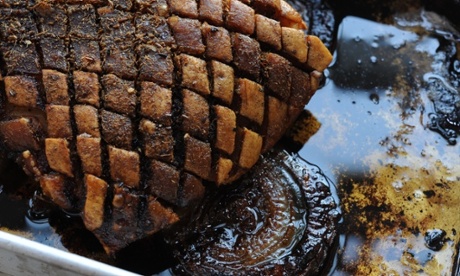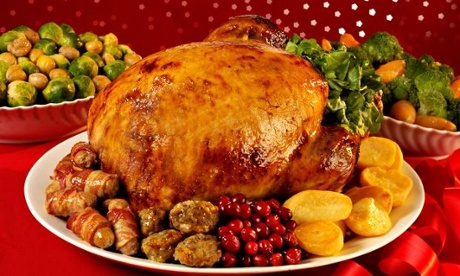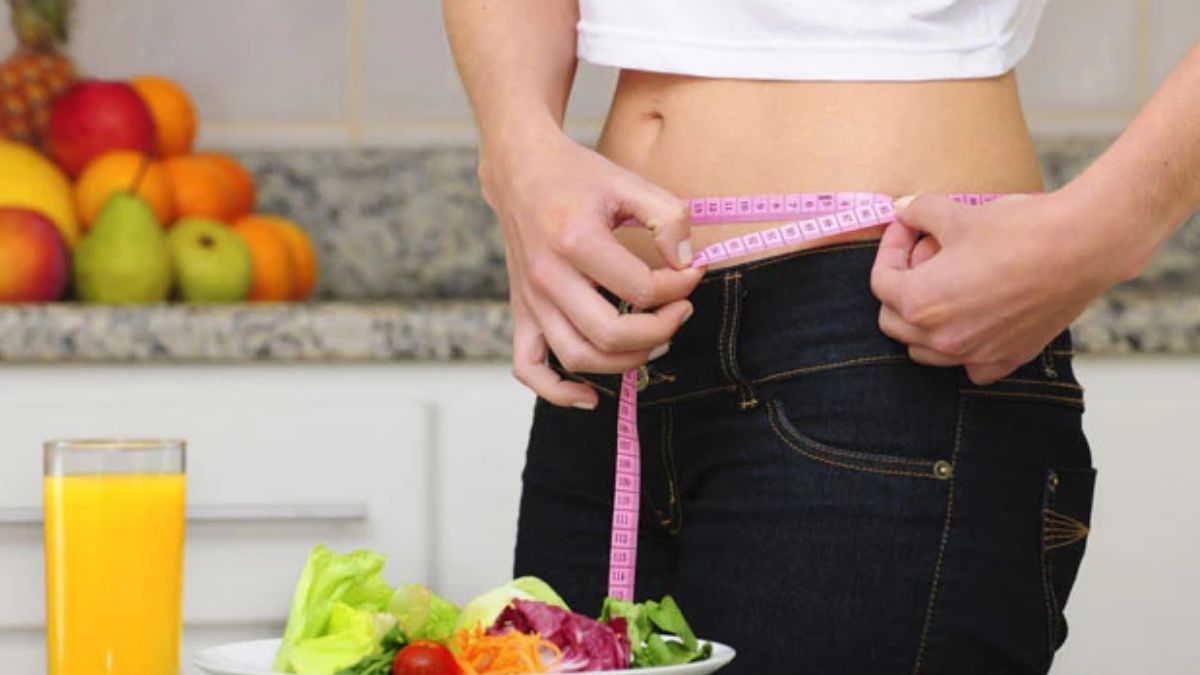There's a difference between 'bred free range' and truly free range pork. But do consumers and our butchers know the difference?
"It's free range" says my butcher pointing at the leg of ham behind the glass display in his shop. "Otway Pork". Thousands of families around Australia will be serving up a ham like this on Christmas day. It's delicious ham but it's not free range.
A close read of the label shows Otway Pork's pigs are actually "bred free range" which is a very different system of farming. The RSPCA defines free range as animals that are not closely confined and have some access to the outdoors. "How much access, how often, and how big the outdoor area is can vary greatly," says the RSPCA.
Bred free range occurs where piglets are born outdoors but transferred at around 21 days of age to sheds where they are grown intensively for up to four months.

Perfect crackling sitting proudly atop a luscious pork belly with cider gravy.Photograph: Jill Mead/Guardian
Free range pork: "Pigs on acres and acres of paddocks"
Free range pork farmer Tammi Jonas raises pastured rare-breed Large Black pigs on her farm in Eganstown Victoria. She's sick of bred free range systems being represented as free range farming.
"The problem is people think they are buying free range and free range is like my pigs, pigs on acres and acres of paddocks. Aside from quality of life for the animal the quality of the meat is radically different from an animal that has roamed the paddocks and used all its muscles," Jonas says.
"Free range is much tastier and much darker in colour." But Jonas' farm does not have any free range accreditation. "Our stance on that is we are certified by the community," Jonas says. "We run an open farm, people can turn up any time of day and see how the animals are raised and report back on social media. I don't need an independent accreditor I have independent eaters turning up."
Bred free range pork: Deep litter housing
Consumers are prepared to pay more for free range meat so it's an area the Australian Competition and Consumer Commission is keeping a close eye on.
Earlier this year the watchdog accepted an undertaking from Saskia Beer, daughter of chef Maggie Beer, for representing small goods she sold under the Barossa Farm Produce label were free range when they were not. For its part, industry body, Australian Pork, distinguishes between "free range" and "outdoor bred" pork.
"Outdoor bred" pork which Otway Pork refers to as "bred free range" is defined by Otway Pork to mean piglets born and raised under free range standards until weaning (at around 10 weeks of age) when they move to deep litter housing for "growing" or "finishing".
Otway Pork's website describes its deep litter housing systems as "large open sided sheds" with flooring made from rice hull, straw or sawdust. Jonas describes the bred free range system as "better than the old industrial model".
"The rise of that production model in the last 10 years has been a positive sign as it is much higher animal welfare standard," she says. "But its unfair to actual free range farmers to have Otway Pork and Western Plains pork described as free range."
Otway Pork and Western Plains Pork failed to respond to requests for comment but Jonas says in the operators' defence their pork is properly labelled, it is butchers and restaurants which inaccurately describe the pork as free range.
Industrial pork
The difference between free range pork and bred free range is a distinction the majority of Australian families don't grapple with when choosing their Christmas ham. Australian Pork calculates Australians consume about 13,500 tonnes of ham per year, with 65% sold around Christmas.
Of the total sales, around two thirds of ham is made from imported pork where there are no controls over farming, animal welfare or environmental standards. Katana Smith, spokesperson for Australian Pork, says the industry body's data is "not granular enough" to identify the amount of Australian Pork sold which is free range.
"A lot of free range hams are sold through farmers markets so it's difficult to track," Smith says.
Turkey time
Turkey is the traditional choice on Christmas day but like free range pork there's no legally enforceable definition of free range for turkeys in Australia. As long as the turkeys have access to the outdoors they can be called free range but the conditions turkeys are farmed in vary significantly.

Turkey - a traditional Christmas favourite.Photograph: Alamy
The two major accreditation systems are the Free Range Egg & Poultry Association and the RSPCA Approved Farming Scheme. Both of these require turkeys to have access to the outdoors with restricted numbers of birds in indoor spaces.
But like Jonas free range turkey farmer Daryl Deutscher doesn't have any accreditation. Deutscher runs Deutscher's Turkey Farm in Dadswells Bridge Victoria where he breeds and raises Australia's largest range of rare turkeys.
The turkeys are initially kept indoors "until they are big enough to go outside to face the weather" which typically occurs at around 10 weeks. Deutscher's turkeys then roam around freely until they are slaughtered ready for Christmas roasts.
"We have chosen not to be accredited with anyone what we say is what we do," Deutscher says. "The accreditation system is so loose, the big companies direct the government as to what they want to be accredited with."
Deutscher says his customers don't need FREPA or RSPCA accreditation to be satisfied their turkeys have been treated well.A lie or mistake? My butcher says describing the ham he is selling as free range rather than bred free range was an honest mistake.
But Jonas says she is "increasingly cynical" about the frequency of these mistakes in describing the meat we are sold. "I have been in some butchers and shared with them what free range really is and I've gone back a few weeks later and it's still there," she says.
"I am troubled by the unfairness of people not being able to make a choice they want to make if they are being lied to. That makes me livid."
Pigs transferred from pasture to pen at 21 days of age are labelled 'bred free range'. Photograph: Charity Burggraaf/Getty Images/Flickr RF






